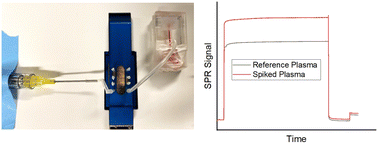A microfluidic plasma separation device combined with a surface plasmon resonance biosensor for biomarker detection in whole blood†
Abstract
Biomarker detection in whole blood enables understanding of the cause, progression, relapse or outcome of treatment of a disease. Conventional biomarker detection techniques, such as enzyme-linked immunosorbent assay, polymerase chain reaction, and immunofluorescence, require long assay time, costly laboratory instruments, large reagent volume and sample pre-processing. Hence, there is an unmet need for reliable capture and detection of biomarkers in unprocessed blood which are adaptable to point-of-care (POC) testing. Here, we present a simple, low-cost, and rapid protein detection device from whole blood samples which has the potential to be employed in a POC setting. The platform consists of two components: a plasma separation device that extracts plasma from whole blood without the application of any external active forces and a SPR sensor chip that uses a label-free optical technique for the detection of biomarkers in the extracted plasma. We have demonstrated the detection of IgG and IgM biomolecules in unprocessed blood at concentrations lower than the physiological value within 15 min. The proposed technique has the potential for improving the diagnosis and screening of many diseases, including cancer, influenza, human immunodeficiency virus, and SARS-Cov2 at POC.



 Please wait while we load your content...
Please wait while we load your content...